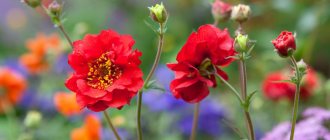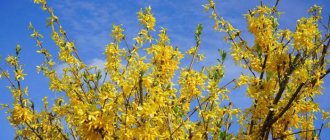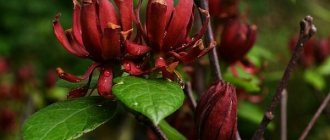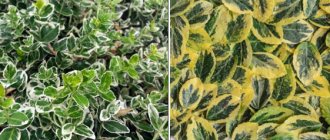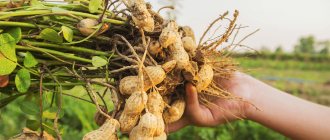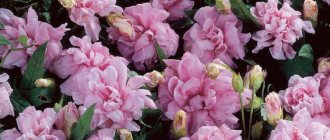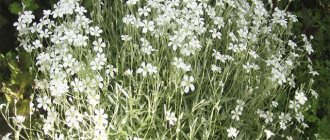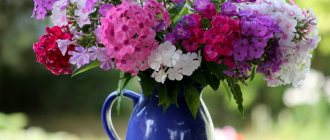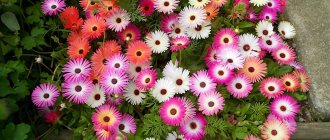Muhlenbergia hairy, often grown from seed, is a perennial ornamental grass popularly called “Deer Grass.” The plant is valued for its unusual flowering.
Pink flowers first bloom on thin panicles, and by the end of summer the flowering grass turns into a white fluffy cloud. The color then changes to purple and light brown. Muhlenbergia hairy is grown from seeds in the garden, but you need to know the rules for sowing and caring for plantings.
Botanical characteristics of the plant
Muhlenbergia is an ornamental plant native to North America, reaching a height of 30 cm.
Under natural conditions, it grows along roadsides in dense thickets or single plants, and also develops in prairies, in well-lit clearings.
Muhlenbergia capillaris0 - photo
The perennial is heat-loving, so in regions where in winter the temperature drops below -18 °C, it will not be possible to grow this beauty.
When looking at Muhlenbergia capillaris0 from afar, it gives the impression of a light purple haze. Stems are straight, unbranched. At the very top there are pink or purple-red inflorescences.
The size of the silky panicles is quite large: they reach 25.5 cm in width and 45.7 cm in length. Flowering is long-lasting, beginning in mid-summer and lasting for 6-7 weeks. Ripe seeds also have an attractive decorative appearance.
The plant tolerates pruning and bush shaping very well. Therefore, it is widely used by gardeners in border design and creating beautiful “islands” on the site.
Garden in a purple haze: what is Muhlenbergia
This decorative perennial is a bright representative of herbs from the Cereals family. The genus Muhlenbergia includes several species, the most spectacular of which is Muhlenbergia hairy, which is also called “deer grass.”
The plant's homeland is the Kansas steppes, Florida prairies and most of the Middle Eastern United States. Muhlenbergia hairy often grows in groups, forms dense plantations, birds hide under its thickets, and small animals find shelter.
Note: the origin of the perennial explains its resistance to drought, poor and saline soils.
Botanical portrait: general description
- Muhlenbergia hairy is a perennial herb that forms a voluminous spreading bush 50-90 cm high and wide.
- The leaves are long, dark green, hard, 2-5 mm wide and 30 cm long.
- The stems are very strong, reminiscent of wire, so the local population uses them for weaving baskets.
- The root system is powerful, branched, suitable for obtaining maximum moisture during periods of drought.
- Numerous pink or purple inflorescences are collected in voluminous silky panicles, each of which reaches 20-25 cm in width and 35-45 in length.
- Flowers are also called “diffuse” because they do not have clear outlines and appear as a smoky clump.
- Flowering of Muhlenbergia hairy begins at the end of summer and lasts 1.5-2 months.
- Ripe seeds are brown, cover the bush abundantly, and look very decorative.
About winter hardiness
Muhlenbergia hairy is a heat-loving plant, accustomed to hot summers and not too harsh winters. If, when purchasing, they tell you that it can be grown in any region, do not believe it. The most acceptable conditions for it are:
- Winter - up to -18º C; in colder winters shelter is required.
- Summer is hot, since the most abundant flowering is observed precisely after the heat.
- Absence of spontaneous thaws followed by frosts.
If your site is flooded by cold autumn rains or there is a lot of snow melting on it after a thaw, then it is important to take care of good soil drainage. Otherwise, due to the combination of moisture and cold, the roots of Muhlenbergia hairy can become propped up and freeze.
Note: if your winters are frosty, then before wintering the stems are cut off, the root area is mulched and covered with fallen leaves or sawdust.
Varietal varieties
Based on Muhlenbergias growing in the southeast of America, many hybrid varieties have been bred, the designation of which contains the word “Undaunted”. From English this term is translated as “fearless,” which best characterizes an ornamental crop that is resistant to heat and drought.
The following varieties of Muhlenbergia are used today to decorate areas:
- White Muhlenbergia White Cloud - creates a white fog effect with abundant flowering.
- Muhlenbergia reverchonii – ruby, pleases with pink-crimson flowers.
- Pink Muhly Grass - thin blue-green stems with airy pink inflorescences.
Hybrid forms are grown in the same way as classic deer grass. Thanks to selective selection, many of them are much more tolerant of cold weather than the mother species.
Growing Muhlenbergia hairy from seeds
Sowing seeds can be done in May, when the threat of spring frosts has passed. Many people practice winter sowing.
In the middle zone, it is not recommended to sow seeds in open ground for the winter, as there is a high probability of them freezing.
Sowing seeds in open ground
Muhlenbergia hairy seeds - photo
Before sowing in open ground, you need to prepare the area: dig it up, remove weeds and stones. The seeds are sown superficially and then raked into the soil.
When sowing in winter, a 5 cm layer of soil is poured onto the flowerbed and mulched with dry leaves or peat on top.
After the seedlings appear, the plantings need to be thinned out, leaving a distance of at least 0.5 meters between plants.
If this rule is neglected, the plantings may subsequently be affected by fungal diseases, since there will not be sufficient air exchange.
Growing Muhlenbergia from seeds in seedlings
Planting Muhlenbergia through seedlings is the most reliable way to grow an ornamental grass.
At the end of March, you need to sow the seeds in containers filled with nutritious soil. The seeds are quite small, so they cannot be buried when sowing. After they are evenly distributed over the surface of the soil, it is recommended to press down lightly so that they come into contact with the moist soil.
After sowing, the containers should be covered with glass to create greenhouse conditions. Seeds will germinate faster if the container is placed in the sunniest place and the temperature is maintained at +20-22 °C. From time to time you need to ventilate the plantings and moisten the soil.
It cannot be said that the seedlings hatch out of the ground together. Germination is observed throughout the month. Caring for seedlings is simple: it is recommended to thin them out, leaving the strongest plants. You need to dive into separate cups.
Planting seedlings in open ground is carried out in mid-May. Before transshipment, the plants need to be moistened so as not to damage the root system during replanting. Muhlenbergia grown from seedlings and transplanted into open ground will develop faster if, during transplantation, the root collar is not buried, but left at the level of the soil surface.
Reproduction of Muhlenbergia hairy by dividing the rhizome
Overgrown bushes are propagated by division. To do this, it is not necessary to dig the entire bush out of the soil.
The plant does not withstand transplantation very well.
It is enough to undermine the Muhlenbergia bush a little from the side and separate the rhizome with growth buds.
The hole for the division is dug in accordance with the size of the root ball, a handful of humus and some mineral fertilizers are placed at the bottom.
Plant a separated bush in the same way as planting seedlings.
Caring for Muhlenbergia in open ground
Muhlenbergia hairy - photo
The ornamental plant is undemanding to soil and maintenance conditions, and therefore does not require constant special care.
Care consists of watering the plantings, which is carried out as the earthen clod dries out, applying fertilizers twice a season and weeding from weeds.
Watering and fertilizing
The plant can survive temporary drought, but if the soil is kept moist, deer grass forms a gorgeous, spreading bush. But when watering, it is important to take into account that a constant “swamp” will lead to rotting of the root system.
For beauty and splendor, it is necessary to feed the cereal with mineral complex fertilizer 2 times during the growing season.
What else should you pay attention to?
In order for Muhlenbergia to give lush flowering, it is recommended:
- in early spring, remove last year's foliage and loosen the soil;
- feed the plant at the beginning of the growing season and after pruning, using fertilizers diluted in half concentration;
- do not allow the soil to dry out for a long time;
- Maintain a distance between plants, otherwise the plantings will become thicker.
Interestingly, the tough stems of grass make it unattractive to insect pests.
Using Muhlenbergia for decorative purposes.
Muhlenbergia is most often used in borders and in the center or background of perennial beds. Muhlenbergia hairy is an excellent groundcover for areas with poor soils and an exquisite specimen grass for natural country or rustic gardens. Muhlenbergia is sown en masse - this way it looks more impressive.
Muhlenbergia stems are also used for decorative weaving. Muhlenbergia is a well-known attractant for beneficial insects that fight aphids, such as beetles, ladybugs, and also as an excellent ornamental garden plant.
Collecting seeds
Muhlenbergia hairy in landscape design - photo
They begin collecting seeds at the end of autumn, when the inflorescences begin to fade, that is, their color loses saturation. Deer grass produces a lot of seeds, so you can stock up on them and share them with friends.
After collection, it is recommended to dry the seeds. To do this, they need to be scattered in a thin layer on a newspaper. It is better to dry in a dark room.
If you are unable to collect the seeds, you can buy them in a retail chain, since the plant is not considered rare. When purchasing, you should pay attention to the harvesting time, since recently collected seeds have greater germination.
Frequent problems in plant care
Overwatering can lead to fungal root rot diseases. Because the crop is drought tolerant, it copes better with a little water than with too much. Extreme cold can cause grass to die. It will die in winter if there is a prolonged period of frost below -23 ° C.
Pests
Your plants will not experience many pest problems. In rare cases, aphids can penetrate tall leaves, but they can be controlled. How to get rid of the pest can be found in our article.
Diseases
Two diseases can occur, but the only serious one is black spot or Phillahora. This fungal disease can damage or kill your plants. To prevent this from getting into your garden, make sure your plants are positioned to allow for adequate air flow.
Another disease that does occur, although rarely, is rust. Regular rust appears as a speck on leaf blades. A common cause is too much moisture or poor air flow. Thin your plants from time to time.
Comments (2)
Alyona
02/12/2020 at 06:41 |
It’s somewhat similar to my favorite myricaria, which I was never able to grow on the plot.. It’s a pity that I’ve never seen seeds here - I would definitely have paid attention. I'll probably have to look for it and order it by mail.Answer
Yulia Expert Plodogorod
02/12/2020 at 16:33 |
Hello, Alena! Please tell us in more detail why it was not possible to grow myricaria on the site? Did the seeds not germinate, did the plants not survive the transplant, or did the adult specimens die?
This culture is considered unpretentious. The main thing for her is to choose a sunny place that is protected from strong winds and cold drafts. The soil is best suited loamy, moist. Miricaria develops normally in partial shade, although it blooms less profusely in such conditions.
Perhaps the crop did not develop well if the site has clayey and dense soil. In this case, we recommend adding peat and ash to the soil and pouring a layer of drainage into the planting hole. The root collar should remain at soil level when planting. It is better to mulch the bush after planting, so the necessary moisture will be retained in the soil longer.
Sometimes myricaria does not tolerate winter well. It is better to tie the shoots so that they do not break under the snow, and the soil under the plant and the root collar should be carefully covered with agrofibre or other breathable material. At the beginning of spring it is worth carrying out remedial pruning.
Sometimes, instead of miricaria, they can sell another very similar crop - tamarix. This plant does not tolerate cold well and requires special preparation for winter.
Answer
Distribution on site
Muhlenbergia has an excellent combination with miscanthus, pennisetum and other ornamental grasses. Plants are planted in groups or individually, at a great distance from other species.
Deer grass is ideal for covering a large vacant lot. Plants are good for decorating slopes. Spreading over them, the pinkish cloud looks amazing. It produces the maximum visual effect if planted en masse .
Empty spaces on the site can also be used well. Here you can create a flower bed of cereal perennials. Then you won’t have to redo anything for next year either. But the cereal combination requires a background, a wall of stone, brick, or an open area.
Compositions with cereals give the area a natural movement, which is so often lacking in the garden. The grass swaying in the wind resembles waves in the sea. And the space itself is filled with rustling. The flower bed in which cereals grow must be fenced so that the grass does not grow beyond its territory. To preserve the decorative appearance of the bush, they are planted in buckets without a bottom. In this case, try to use different colors and shapes .
Diseases and pests
Pests rarely attack deer grass. Possessing a characteristic odor that is attractive to beneficial insects (predatory bugs, ladybugs, predatory beetles, etc.), it is an attractant. Occasionally, mites or aphids can be found on Muhlenbergia hairy. In this case, spraying with insectoacaricides (Akarin, Inta-Vir, etc.) is indicated.
With high humidity, the roots of this decorative feather grass rot and begin to rot, so you should be more careful with watering. The culture is very drought-resistant and can generally do without additional moisture. The need for moisture in Muhlenbergia hairy appears only in extreme heat, when the tips of the leaves of the plant may turn yellow and dry out.
It is recommended to place neighboring specimens at a distance of no closer than half a meter from each other, since in thickened grass plantings of Muhlenbergia hairy, fungal pathologies may appear (powdery mildew, rust, etc.).
Wildlife in Landscape Design
Cereals are very often used in styles where the main concept is closeness to nature. Thanks to ornamental grasses, a piece of wild nature is introduced into the garden landscape. The simplicity and naturalness of the site is preserved all year round.
Muhlenbergia is a herbaceous perennial grass native to North America. Its second name is deer grass. It grows wild in the east of the country on the prairies and on roadsides. It can be seen both solitary and in the form of dense thickets.
Muhlenbergia hairy is an ornamental, very beautiful and unusual plant. In our country it is rarely used in landscape design, but in the West it is very common.
Botanical portrait
The most prominent representative of the genus, used in floriculture in many countries.
Its homeland is prairies and pine forests from Massachusetts to Kansas, South Florida and Texas.
In Missouri, it is most often found in acidic soils in open woods, clearings, or road openings, primarily in the central and western areas south of the Missouri River. The specific epithet is translated from Latin as “thin or hair-like.”
The glossy, stringy, thread-like, dark green leaves and stems form an attractive bush, 30 to 90 cm high and approximately 30 to 60 cm wide.
It is in autumn that the plant is especially attractive: masses of airy, open, weakly branched inflorescences of pinkish-red shades float and move above the foliage during prolonged flowering. Ears of grain remain decorative throughout the winter.
Ornamental grass is very popular in landscape design.
In addition to the species plant, varieties with different ear colors have been bred:
Optimal growing conditions.
Light: sunny area or partial shade. Shade tolerant
Moisture: Additional watering is usually not required; it is drought tolerant.
Soil: Tolerates a variety of soils from moist to dry, acidic to alkaline. Prefers moderately acidic organic soils with a pH range of 5.5 to 6.8
Hardiness: USDA zones 5 - 10.
Reproduction: Well grown from seeds. Can be replanted by dividing an adult plant.
Diseases and pests: practically none

